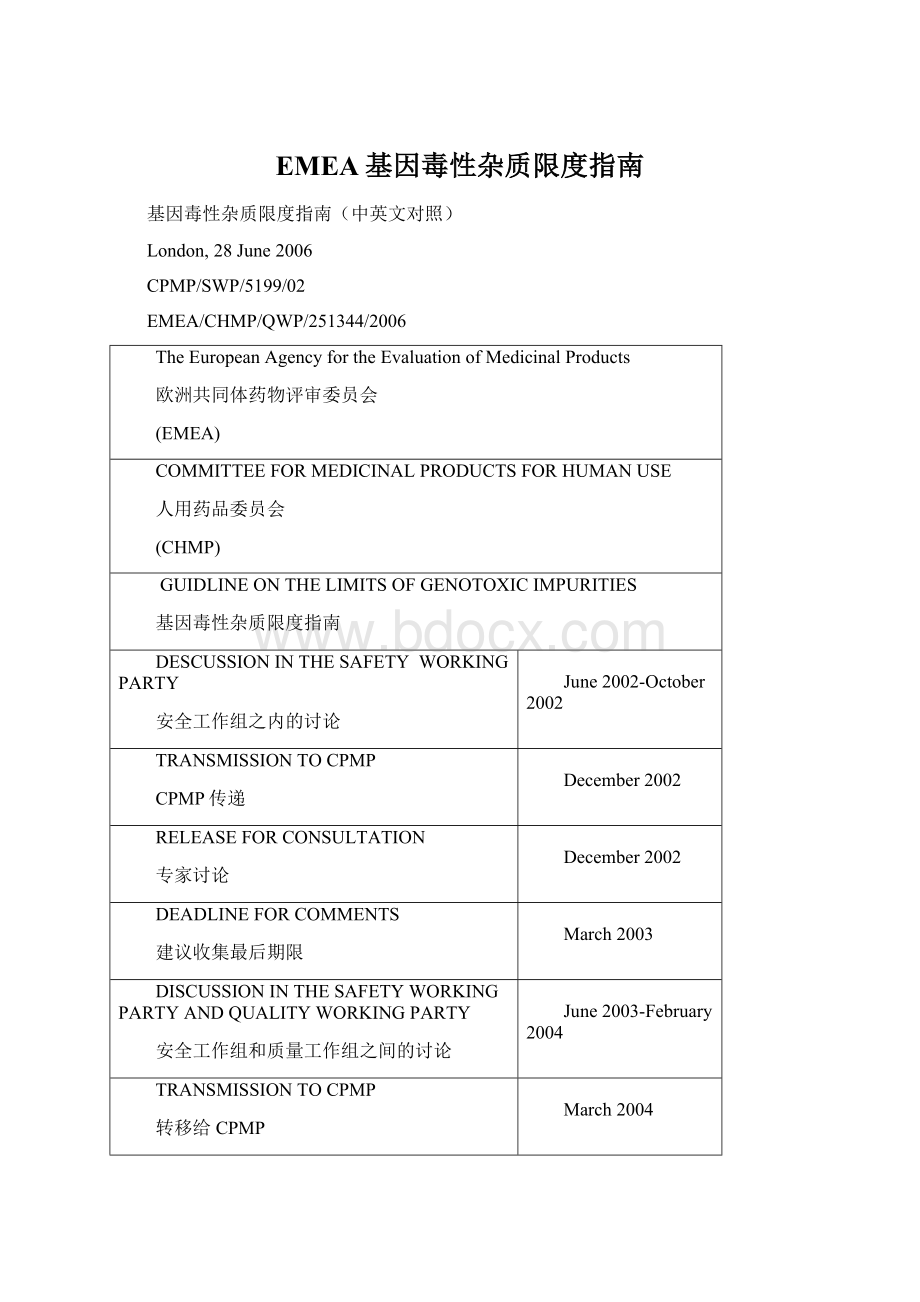EMEA基因毒性杂质限度指南.docx
《EMEA基因毒性杂质限度指南.docx》由会员分享,可在线阅读,更多相关《EMEA基因毒性杂质限度指南.docx(12页珍藏版)》请在冰豆网上搜索。

EMEA基因毒性杂质限度指南
基因毒性杂质限度指南(中英文对照)
London,28June2006
CPMP/SWP/5199/02
EMEA/CHMP/QWP/251344/2006
TheEuropeanAgencyfortheEvaluationofMedicinalProducts
欧洲共同体药物评审委员会
(EMEA)
COMMITTEEFORMEDICINALPRODUCTSFORHUMANUSE
人用药品委员会
(CHMP)
GUIDLINEONTHELIMITSOFGENOTOXICIMPURITIES
基因毒性杂质限度指南
DESCUSSIONINTHESAFETYWORKINGPARTY
安全工作组之内的讨论
June2002-October2002
TRANSMISSIONTOCPMP
CPMP传递
December2002
RELEASEFORCONSULTATION
专家讨论
December2002
DEADLINEFORCOMMENTS
建议收集最后期限
March2003
DISCUSSIONINTHESAFETYWORKINGPARTYANDQUALITYWORKINGPARTY
安全工作组和质量工作组之间的讨论
June2003-February2004
TRANSMISSIONTOCPMP
转移给CPMP
March2004
RE-RELEASEFORCONSULTATION
再次放行给顾问团
June2004
DEADLINEFORCOMMENTS
收集意见的最后期限
December2004
DISCUSSIONINTHESAFETYWORKINGPARTYANDQUALITYWORKINGPARTY
安全工作组和质量工作组之间的讨论
February2005-May2006
ADOPTIONBYCHMP
被CHMP采用
28June2006
DATEFORCOMINGINTOEFFECT
生效日期
01January2007
KEYWORDS
关键词
Impurities;Genotoxicity;Thresholdoftoxicologicalconcern(TTC);Structureactivityrelationship(SAR)
GUIDLINEONTHELIMITSOFGENOTOXICIMPURITIES
基因毒性杂质限度指南
TABLEOFCONTENTS目录
EXECUTIVESUMMARY内容摘要..............................................................................................3
1.INTRODUCTION介绍...............................................................................................................3
2.SCOPE范围...............................................................................................................................3
3.LEGALBASIS法律依据............................................................................................................3
4.TOXICOLOGICALBACKGROUND毒理学背景....................................................................4
5.RECOMMENDATIONS建议.....................................................................................................4
5.1GenotoxicCompoundsWithSufficientEvidenceforaThreshold-RelatedMechanism
具有充分证据证明其阈值相关机理的基因毒性化合物.........................................................4
5.2GenotoxicCompoundsWithoutSufficientEvidenceforaThreshold-RelatedMechanism
不具备充分证据支持其阈值相关机理的基因毒性化合物......................................................5
5.2.1PharmaceuticalAssessment药学评价..................................................................................5
5.2.2ToxicologicalAssessment毒理学评价...................................................................................5
5.2.3ApplicationofaThresholdofToxicologicalConcern毒理学担忧阈值应用........................5
5.3DecisionTreeforAssessmentofAcceptabilityofGenotoxicImpurities
基因毒性杂质可接受性评价决策树..........................................................................................7
REFERENCES.参考文献................................................................................................................8
EXECUTIVESUMMARY内容摘要
ThetoxicologicalassessmentofgenotoxicimpuritiesandthedeterminationofacceptablelimitsforsuchimpuritiesinactivesubstancesisadifficultissueandnotaddressedinsufficientdetailintheexistingICHQ3Xguidances.Thedatasetusuallyavailableforgenotoxicimpuritiesisquitevariableandisthemainfactorthatdictatestheprocessusedfortheassessmentofacceptablelimits.Intheabsenceofdatausuallyneededfortheapplicationofoneoftheestablishedriskassessmentmethods,i.e.datafromcarcinogenicitylong-termstudiesordataprovidingevidenceforathresholdmechanismofgenotoxicity,implementationofagenerallyapplicableapproachasdefinedbytheThresholdofToxicologicalConcern(TTC)isproposed.ATTCvalueof1.5μg/dayintakeofagenotoxicimpurityisconsideredtobeassociatedwithanacceptablerisk(excesscancerriskof<1in100,000overalifetime)formostpharmaceuticals.Fromthisthresholdvalue,apermittedlevelintheactivesubstancecanbecalculatedbasedontheexpecteddailydose.Higherlimitsmaybejustifiedundercertainconditionssuchasshort-termexposureperiods.
基因毒性杂质的毒理学评估和这些杂质在活性药物中的可接受标准的测定是一件困难的事情,并且在现有的ICHQ3X指南中也没有详细的规定。
现有的关于基因毒性杂质的相关数据是容易变化的,也是对杂质可接受标准如何进行评价的主要影响因素。
如果缺少风险评估方法所需要的数据,比如,致癌作用的长期研究数据,或为基因毒性的阀值提供证据的数据,一般建议使用一般通用的被定义为毒理学关注的阈值(TTC)的方法。
一个“1.5μg/day”的TTC值,即相当于每天摄入1.5μg的基因毒性杂质,被认为对于大多数药品来说是可以接受的风险(一生中致癌的风险小于十万分之1)。
按照这个阀值,可以根据这个预期的每日摄入量计算出活性药物中可接受的杂质水平。
较高的临界值可以在特定的条件下,如短期暴露周期等,进行推算。
1.INTRODUCTION介绍
Ageneralconceptofqualificationofimpuritiesisdescribedintheguidelinesforactivesubstances(Q3A,ImpuritiesinNewActiveSubstances)ormedicinalproducts(Q3B,ImpuritiesinNewMedicinalProducts),wherebyqualificationisdefinedastheprocessofacquiringandevaluatingdatathatestablishesthebiologicalsafetyofanindividualimpurityoragivenimpurityprofileatthelevel(s)specified.Inthecaseofimpuritieswithagenotoxicpotential,determinationofacceptabledoselevelsisgenerallyconsideredasaparticularlycriticalissue,whichisnotspecificallycoveredbytheexistingguidelines.
在原料药(Q3A)和药物制剂(Q3B)的杂质指导原则中,杂质限度确定的依据包括各个杂质的生物安全性数据或杂质在某特定含量水平的研究概况。
而对于遗传毒性杂质限度的确定,通常都认为是特别关键的问题,但目前尚无相关的指导原则。
2.SCOPE范围
ThisGuidelinedescribesageneralframeworkandpracticalapproachesonhowtodealwithgenotoxicimpuritiesinnewactivesubstances.Italsorelatestonewapplicationsforexistingactivesubstances,whereassessmentoftherouteofsynthesis,processcontrolandimpurityprofiledoesnotprovidereasonableassurancethatnoneworhigherlevelsofgenotoxicimpuritiesareintroducedascomparedtoproductscurrentlyauthorisedintheEUcontainingthesameactivesubstance.ThesamealsoappliestovariationstoexistingMarketingAuthorisationspertainingtothesynthesis.Theguidelinedoes,however,notneedtobeappliedretrospectivelytoauthorisedproductsunlessthereisaspecificcauseforconcern.
本指导原则阐述了如何处理新原料药中遗传毒性杂质的一般框架和实际方法。
该指导原则也适用于已有原料药的新申请,如果其合成路线、过程控制和杂质研究尚无法确保不会产生新的或更高含量的遗传毒性杂质(与EU目前批准的相同原料药相比)。
该指导原则同样适用于已上市原料药有关合成方面的补充申请。
除非有特殊原因,本指导原则不适用于已上市的产品。
Inthecurrentcontexttheclassificationofacompound(impurity)asgenotoxicingeneralmeansthattherearepositivefindingsinestablishedinvitroorinvivogenotoxicitytestswiththemainfocusonDNAreactivesubstancesthathaveapotentialfordirectDNAdamage.Isolatedinvitrofindingsmaybeassessedforinvivorelevanceinadequatefollow-uptesting.Intheabsenceofsuchinformationinvitrogenotoxicantsareusuallyconsideredaspresumptiveinvivomutagensandcarcinogens.
目前对于基因毒性杂质的分类主要是指:
在以DNA反应物质为主要研究对象的体内体外试验中,如果发现它们对DNA有潜在的破坏性,那可称之为基因毒性。
如果有足够的后续试验,可由单独的体外试验结果,对它的体内关联性进行评估。
在缺乏这样的信息时,体外基因毒性物质经常被考虑为假定的体内诱变剂和致癌剂。
3.LEGALBASIS法规依据
ThisguidelinehastobereadinconjunctionwithDirective2001/83/EC(asamended)andallrelevantCHMPGuidancedocumentswithspecialemphasison:
在阅读该指南时有必要参考“Directive2001/83/EC”以及相关的CHMP指南文件,特别是以下几个指南:
ImpuritiesTestingGuideline:
ImpuritiesinNewDrugSubstances(CPMP/ICH/2737/99,ICHQ3A(R))
NoteforGuidanceonImpuritiesinNewDrugProducts(CPMP/ICH/2738/99,ICHQ3B(R))
NoteforGuidanceonImpurities:
ResidualSolvents(CPMP/ICH/283/95)
NoteforGuidanceonGenotoxicity:
GuidanceonSpecificAspectsofRegulatoryGenotoxicityTestsforPharmaceuticals(CPMP/ICH/141/95,ICHS2A)
NoteforGuidanceonGenotoxicity:
AStandardBatteryforGenotoxicityTestingofPharmaceuticals(CPMP/ICH/174/95,ICHS2B)
4.TOXICOLOGICALBACKGROUND毒理学背景
Accordingtocurrentregulatorypracticeitisassumedthat(invivo)genotoxiccompoundshavethepotentialtodamageDNAatanylevelofexposureandthatsuchdamagemaylead/contributetotumourdevelopment.Thusforgenotoxiccarcinogensitisprudenttoassumethatthereisnodiscerniblethresholdandthatanylevelofexposurecarriesarisk.
根据目前的研究实践,具有(体内)遗传毒性的化合物在任何暴露量下都有可能对DNA产生损伤,而这种损伤可能会引发肿瘤。
因此,对于遗传毒性致癌物质,应谨慎认为不存在明确的阈值,任何暴露量下都存在风险。
However,theexistenceofmechanismsleadingtobiologicallymeaningfulthresholdeffectsisincreasinglyacknowledgedalsoforgenotoxicevents.Thisholdstrueinparticularforcompoundsinteractingwithnon-DNAtargetsandalsoforpotentialmutagens,whicharerapidlydetoxifiedbeforecomingintocontactwithcriticaltargets.Theregulatoryapproachtosuchchemicalscanbebasedontheidentificationofacriticalno-observed-effectlevel(NOEL)anduseofuncertaintyfactors.
然而,对于一些遗传毒性事件,其产生生物学意义的阈值效应的机理正越来越为人所了解。
对于非DNA靶点的化合物和潜在致突变剂更是如此,因为它们在与关键靶点接触前就已经去毒化了。
对于这些化合物,研究的基础可以是确定关键的未观察到影响的剂量(NOEL)和采用不确定因子。
EvenforcompoundswhichareabletoreactwiththeDNAmolecule,extrapolationinalinearmannerfromeffectsinhigh-dosestudiestoverylowlevel(human)exposuremaynotbejustifiedduetoseveralprotectivemechanismsoperatingeffectivelyatlowdoses.However,atpresentitisextremelydifficulttoexperimentallyprovetheexistenceofthresholdforthegenotoxicityofagivenmutagen.Thus,intheabsenceofappropriateevidencesupportingtheexistenceofathresholdforagenotoxiccompoundmakingitdifficulttodefineasafedoseitisnecessarytoadoptaconceptofalevelofexposurethatcarriesanacceptablerisk.
即使对能与DNA分子发生反应的化合物,由于低剂量时有多种有效的保护机制存在,而不能将高剂量下的影响以线性方式外推到很低的(人)暴露水平。
不过,目前要用实验方法证明某诱变剂的遗传毒性阈值仍然非常困难。
所以,在缺乏恰当的证据支持遗传毒性阈值存在的情况下,确定安全剂量很困难,因此非常有必要采用一个可接受风险的暴露水平概念。
5.RECOMMENDATIONS建议
AsstatedintheQ3Aguideline,actualandpotentialimpuritiesmostlikelytoariseduringsynthesis,purificationandstorageofthenewdrugsubstanceshouldbeidentified,basedonasoundscientificappraisalofthechemicalreactionsinvolvedinthesynthesis,impuritiesassociatedwithrawmaterialsthatcouldcontributetotheimpurityprofileofthenewdrugsubstance,andpossibledegradationproducts.Thisdiscussioncanbelimitedtothoseimpuritiesthatmightreasonablybeexpectedbasedonknowledgeofthechemical